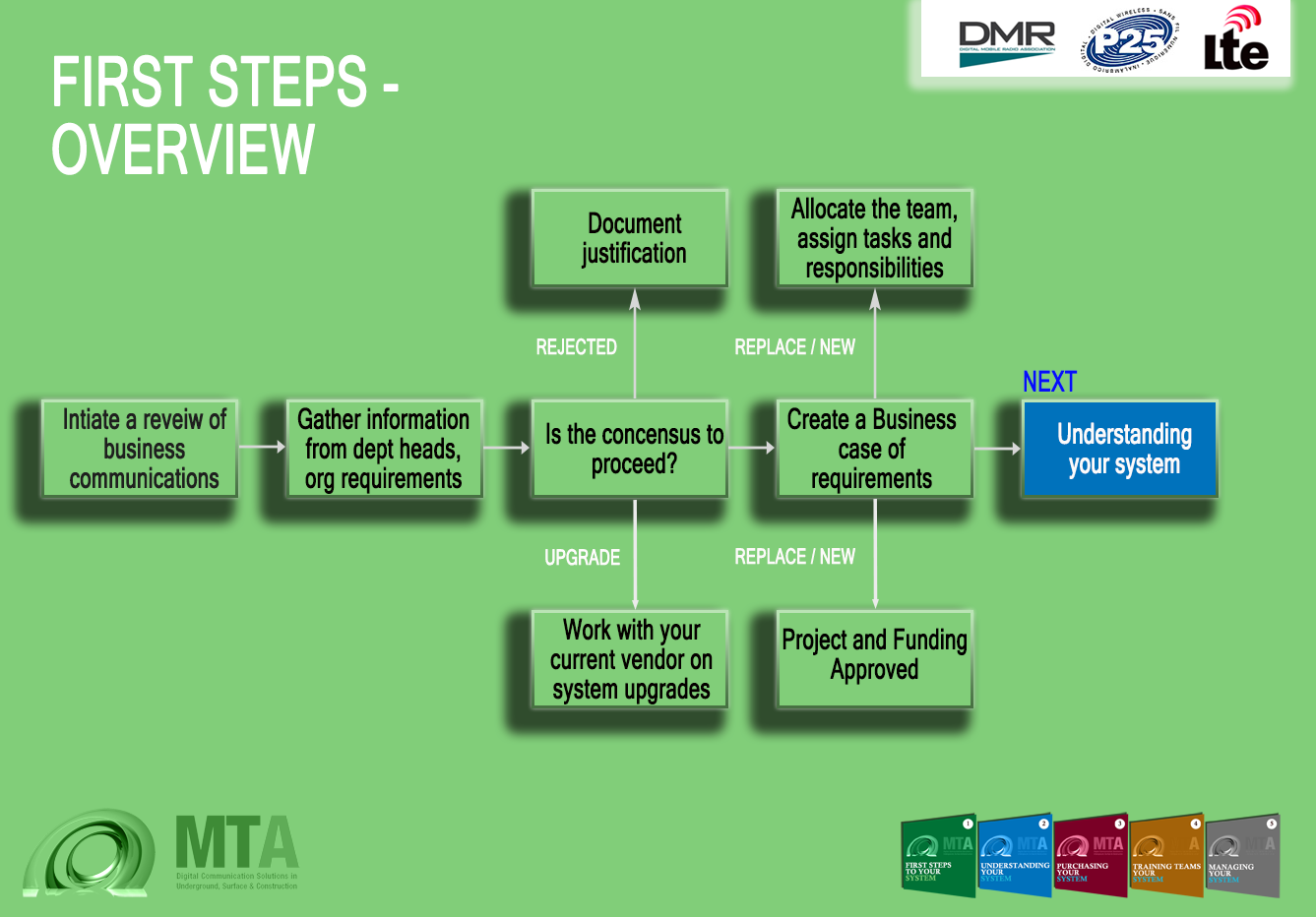Radio Communications System – First Steps
- Where can you turn for expert advice?
- How do you decide whether to upgrade or replace?
- Who are your stakeholders?
- How do you conduct a needs analysis?
- Where can you go to seek funding?
In most cases, the decision to undertake a radio communications project will beforced on you by external circumstances. For example,receiving an End of Life letter from your vendor means you cannot maintain the status quo for an extended period of time, even if your current system is performing to everyone’s satisfaction. Administrative changes – the need to expand/improve coverage or increase system capacity – may also force you to consider replacing or upgrading your system.
Which way to go?
This guide outlines some vital stepsyou can take right now, that will help you make the myriad decisions that lie ahead, and ensure your project runs smoother. Arm yourself with the right information and the right people from the beginning…

We would like to thank Tait for generously sharing their experiences, challenges, wins and frustrations. Together with MiningTelecoms expert advice we have combined these guides to provide valuable insights into the challenges of successfully implementing a DMR, P25, and LTE Private Mobile Network system solution – best practice.
Contents
Setup the project
Securing funds
Status quo analysis
Needs analysis
Acquiring additional spectrum
Insights
Specifying
Identify Radio Communications System Stakeholders
Identifying key stakeholders in your organization and constantly updating them is critical to the success of any communications system project.
Setup meetings constantly especially in the early stages to ensure you have their support and address any of their concerns, or queries. Having regular meetings will help you build the relationship.
Create an open forum where challenging dialog is encouraged. This is vital when discovering underlying concerns, risks, or ideas not previously considered.
A typical list of stakeholders for a Business or Public Safety Land Mobile Radio project…
Radio Users (Site Operations, Managers, First Responders, Public Services and Logistics)
Dispatchers, Site Co-ordinaters
System Administrators
IT, Finance, Program Management Office, Legal, Compliance
Executives, Leadership Teams, Agencies, Engineers
External Parties with interoperability applications, hardware
Define Radio communications System Scope
Defining your system requirements & scope is more complex with today’s digital radios, networks and communication applications.
Digital mobile radio communication networks, wide area trunking technologies, and LTE private mobile networks make the decision process even more complex and challenging.
Replace or Upgrade Your Communications System?
At first sight an upgrade (incremental changes in hardware, software and licensing) sounds easier and cheaper, but a closer look may reveal that first impression to be false.
Your incumbent vendor is unlikely to offer you best pricing unless competitively challenged.
In some cases, the quantity of hardware and software upgrades needed to bring your system to the next platform may be so significant that the cost may be higher than starting anew.
System Administrators
Be wary of requirements for dual mode (old proprietary and new open standard) subscriber radios – that requirement alone may be more costly than a complete new network and new subscriber units.
Think about who you interoperate with…who will be funding the project? Secondly, who will be using the Network? Finally, who are the key influences?
Selecting a Radio Communications System Vendor
It is tempting to simply let your incumbent vendor upgrade
your existing system. However, upgrading via noncompetitive purchase is only recommended under very specific circumstances, such as:
- your current system is performing very well
- current running costs are acceptable
- you have a good relationship with your vendor and local service provider
- you do not require significant capacity expansion or improvement, or
- you need only small incremental changes (such as adding a site, a channel, a software feature).
If all of the above conditions are true for you, you may be better off talking directly to your current vendor, manufacturer, dealer or system integrator. Otherwise you should prepare for an open procurement process.
But more often, replacing your system will lead to better
technology, which is also more cost-effective in the long run.
An increase in communications, tracking, analytics and reporting all leading to a more productive and safe working environment.
Join an Existing Large Radio Communications System
As a stand-alone system owner, you may be under pressure to join larger, typically state-wide, systems. Should you?
In some cases the answer is simple. Larger systems operators are aware of the financial uncertainty these arrangements can bring, and can sometimes offer irresistible incentives, such as:
- excellent system performance and functionality
- low maintenance cost
- excellent technical and logistical support
- low initial investment
- sophisticated interoperability options
- even generous financial credits that enable you to use
the system subscription-free for several years.
Experience unfortunately has shown not all large systems are equally well run and well financed. Businesses relinquishing local control over your own system, risk inferior services, technology that is out of date, and uncontrollable future cost increases.
Special considerations should be given to the long term service level agreement, governance and financing.
Setting up the project
Do nothing?
Doing nothing is rarely an option. However, occasionally such a decision can be justified. For example, the call for change may be prompted by an extraordinary failure of a communications system that otherwise is performing to the satisfaction of the users. If the reasons for failure are fully understood and easily remedied, maintaining the status quo is fully justified.
Perhaps an antenna system failed during a major storm as a result of lightning damage. While the public, the media and politicians might call for drastic change, no technology can provide 100% immunity against the forces of nature and all technologies are vulnerable to some external factors. In this case you should write a report explaining what has happened and justify your course of action – immediate remedies and long term options.
Another hypothetical situation may be the desire of local leaders to load your two way radio system with hundreds of additional non-first responders. You are running a proprietary technology system with expensive subscriber units and all subscriber needs are met. Expanding your system to accommodate additional users is likely to be much more expensive and disruptive than building a separate, low-cost network for them. Write a simple report explaining your recommendation providing some budgetary comparison.
Once you have investigated the positive and negative aspects of upgrading or replacing your radio communications system, and the decision to replace your system has been made, the corresponding project management process basics must be addressed. This should cover all aspects of generic project management practices.
Identify team members – you need representation
of your local Public Safety leadership, purse holders,
system users and technical experts.
Define the project objectives (results, timeline,
budgetary assumptions).
Allocate responsibilities and authority.
Establish clear guidelines on the basics of your project
communications (who, what, when and how often).
You should consider using well-established Project Management concepts, such as those developed by Project Management Institute (PMI), right from the beginning of your project. These processes and guidelines will provide you with valuable checklists to ensure that you do not overlook any important aspects.


